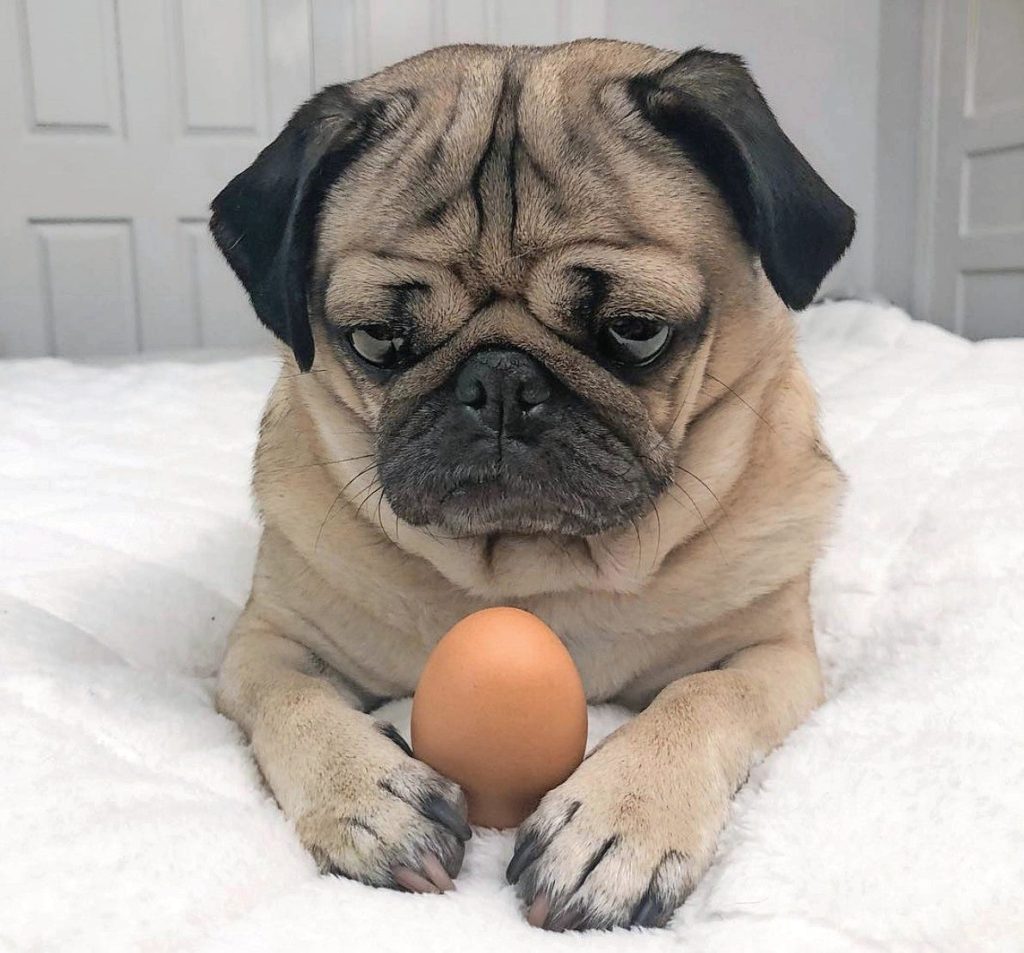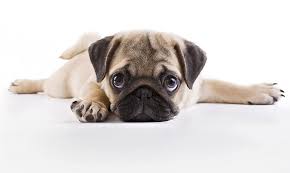The pug is a breed of dog with physically distinctive features of a wrinkly, short-muzzled face, and curled tail. The breed has a fine, glossy coat that comes in a variety of colours, most often fawn or black, and a compact square body with well-developed muscles.
Pugs were brought from China to Europe in the sixteenth century and were popularized in Western Europe by the House of Orange of the Netherlands, and the House of Stuart. In the United Kingdom, in the nineteenth century, Queen Victoria developed a passion for pugs which she passed on to other members of the Royal family.
Pugs are known for being sociable and gentle companion dogs. The AKC describes the breed’s personality as “even-tempered and charming”. Pugs remain popular into the twenty-first century, with some celebrity owners. A pug was judged Best in Show at the World Dog Show in 2004.
Chinese origins

China is the earliest known source for the breed. Similar dogs were popular in the Imperial court during the Song Dynasty.
In ancient times, Pugs were bred to be companions for ruling families in China. The pet Pugs were highly valued by Chinese Emperors, and the royal dogs were kept in luxury and guarded by soldiers. Pugs later spread to other parts of Asia. In Tibet, Buddhist monks kept Pugs as pets in their monasteries. The breed has retained its affectionate devotion to its owners since ancient times.
16th and 17th centuries
Pugs were popular at European courts, and reportedly become the official dog of the House of Orange in 1572 after a Pug named Pompey saved the life of the Prince of Orange by alerting him to the approach of assassins.
A Pug travelled with William III and Mary II when they left the Netherlands to accept the throne of England in 1688. During this period, the Pug may have been bred with the old type King Charles spaniel, giving the modern King Charles Spaniel its Pug characteristics.
The breed eventually became popular in other European countries as well. Pugs were painted by Goya in Spain, and in Italy they rode up front on private carriages, dressed in jackets and pantaloons that matched those of the coachman. They were used by the military to track animals and people and were also employed as guard dogs.
18th century to present day
The English painter William Hogarth was the devoted owner of a series of Pugs. His 1745 self-portrait, which is now in London’s Tate Gallery, includes his Pug, Trump. The Pug was also well known in Italy. In 1789, author Hester Piozzi wrote in her journal, “The little Pug dog or Dutch mastiff has quitted London for Padua, I perceive. Every carriage I meet here has a Pug in it.” The popularity of the Pug continued to spread in France during the eighteenth century. Before her marriage to Napoleon Bonaparte, Joséphine had her Pug Fortune carry concealed messages to her family while she was confined at Les Carmes prison, it having alone been given visiting rights.
In nineteenth-century England, the breed flourished under the patronage of Queen Victoria. Her many Pugs, which she bred herself, included Olga, Pedro, Minka, Fatima and Venus. Her involvement with dogs, in general, helped to establish the Kennel Club, which was formed in 1873. Queen Victoria favoured apricot and fawn colours. Queen Victoria’s passion for Pugs was passed on to many other members of the Royal family, including her grandson King George V and his son King Edward VIII. Many responded to the breed’s image of anti-functionalism and diminutive size during this period.
In paintings and engravings of the 18th and 19th centuries, Pugs usually appear with longer legs and noses than today, and sometimes with cropped ears. The modern Pug’s appearance probably changed after 1860 when a new wave of Pugs was imported directly from China. These Pugs had shorter legs and the modern-style Pug nose. The British aristocrat Lady Brassey is credited with making black Pugs fashionable after she brought some back from China in 1886. Ear cropping was made illegal in 1895.
Pugs arrived in the United States during the nineteenth century and were soon making their way into the family home and the show ring. The AKC recognized the breed in 1885. The Pug Dog Club of America was founded in 1931 and was recognized by the American Kennel Club that same year. In 1981, the Pug Dhandys Favorite Woodchuck won the Westminster Kennel Club Dog Show in the United States, the only Pug to have won there since the show began in 1877. The World Champion, or Best in Show at the 2004 World Dog Show held in Rio de Janeiro, Brazil, was a Pug named Double D Cinoblu’s Masterpiece.
In popular culture
The breed became iconic in India, as it was featured as the mascot in a series of Vodafone (formerly Hutchison Essar) advertising commercials directed by Prakash Varma. The pug that was predominantly featured in the commercials was Cheeka. The advertisement campaign was followed by a rise in the popularity of pugs in India, and the sale of pugs more than doubled within months, with prices for pugs rising considerably. A few other adverts also appeared in the following months, inspired by the idea of a dog following a boy.
The Men in Black film series features Frank the pug, a fictional talking pug played by the animal actor Mushu. Frank has helped to popularize pugs and has become an iconic example of the breed.
